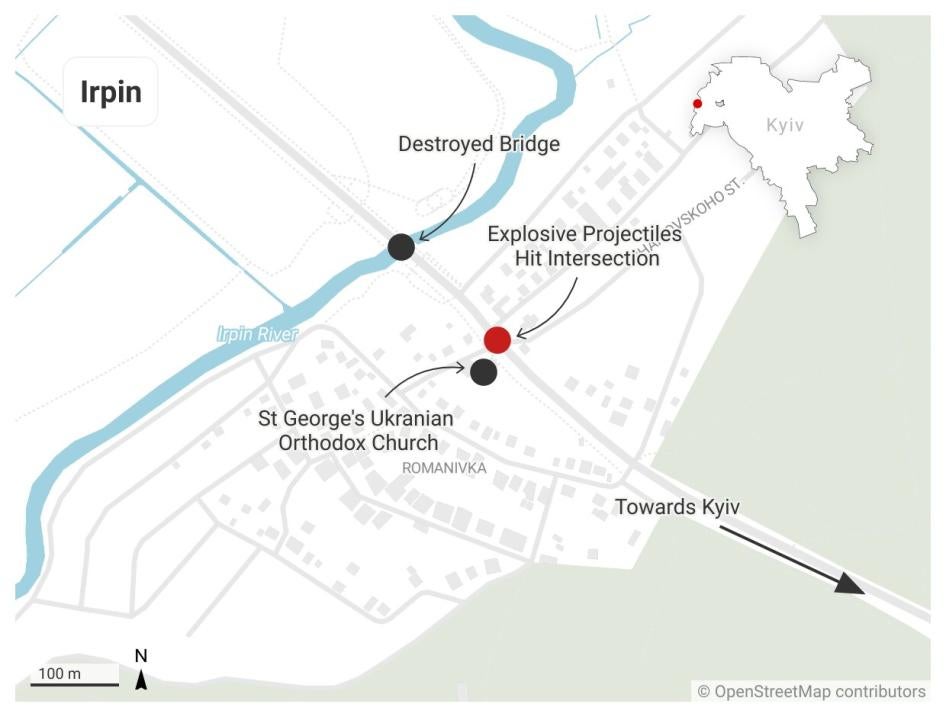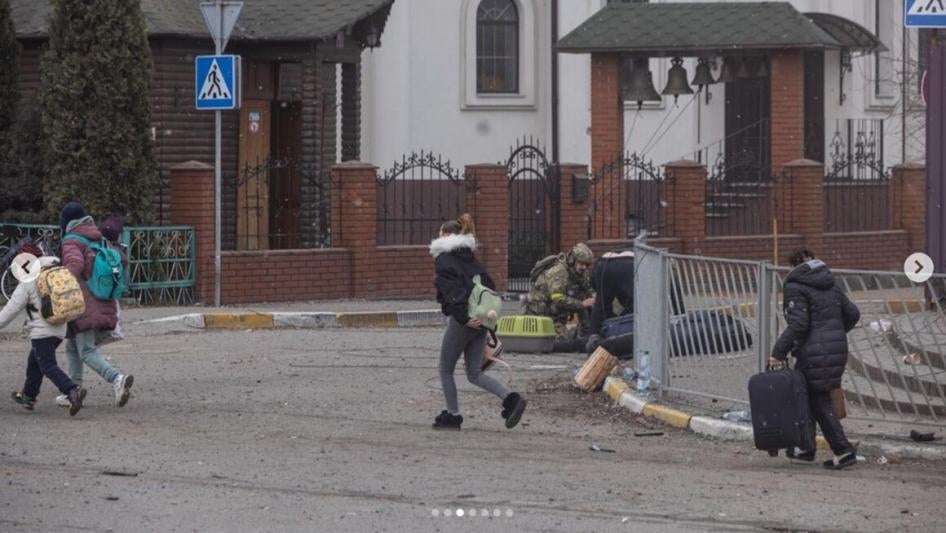For several hours on March 6, 2022, Russian forces bombarded an intersection on a road that hundreds of civilians were using to flee the Russian army's advance in northern Ukraine to Kyiv, Human Rights Watch said today. The repeated nature of the attacks, which according to the government killed at least eight civilians, suggests that Russian forces violated their obligations under international humanitarian law not to conduct indiscriminate or disproportionate attacks that harm civilians, and failed to take all feasible measures to avoid civilian casualties.
According to witnesses, about a dozen Ukrainian security force members and at least two military vehicles were at the intersection during the attack, but they were vastly outnumbered by the large number of fleeing civilians. Some security forces were helping the civilians carry their luggage and children. Witnesses described hearing and seeing exchanges of fire between Ukrainian and Russian forces not in the immediate vicinity of the intersection, but at some distance away. While other witnesses could not be precise about where the exchanges of fire took place, the New York Times, which had journalists on the scene, reported that Ukrainian forces fired mortar rounds in the direction of the Russian forces from a military position about 180 meters from the intersection. Nevertheless, explosive projectiles fired by Russian forces repeatedly hit the intersection.
"Scores of civilians fleeing northern Ukraine to escape Russian shelling and potential occupation found themselves victims of yet another Russian assault," said Richard Weir, crisis and conflict researcher at Human Rights Watch. "The hours-long bombardment on a location with evacuating civilians raises concerns that Russian forces were conducting indiscriminate or disproportionate attacks, and failing to take all feasible precautions to minimize civilian casualties."
Human Rights Watch research and analysis suggests that the projectiles used in the bombardment were possibly observed, meaning that Russian forces were likely tracking or "observing" where they were landing, and that Russian forces had information they could use to adjust targeting. If this is the case, the persistent shelling harming civilians rather than hitting larger military objectives some distance away points to potential recklessness or deliberateness.
Human Rights Watch interviewed seven people who were present during the attacks on March 6, including five linked to the media and two civilians who were evacuating, and analyzed one video of a projectile hitting the intersection and six photographs of the aftermath. According to the local mayor, eight people were killed, including two children. Human Rights Watch gathered information about four people killed during the shelling, including two children, from witness accounts and analysis of photos and videos.
From about 9:30 a.m. until 2 p.m. local time, witnesses described continuous bombardment on the P30 road, which runs from northwestern Ukraine to Kyiv. Until March 5, civilians had been taking the train from Irpin station into Kyiv to escape the fighting, but the railway tracks were damaged in an attack that day. As a result, on March 6, hundreds of civilians fleeing areas north of Kyiv used the P30 road to reach Kyiv, from which they hoped to travel onward.
The intersection is six kilometers from the Kyiv city limits, south of Irpin, just in front of St. George's Ukrainian Orthodox Church and a statue commemorating those who fought in World War II. The intersection is also just south of a bridge that the Ukrainian forces destroyed to deter the Russian advance.
Before and during the attack, witnesses described a steady stream of civilians walking on the rubble of the destroyed bridge to cross the Irpin River. People then gathered at the intersection to board buses or cars heading into central Kyiv, or continued walking.
As the assault began, one witness, who was at the intersection from 9:30 a.m. until noon, said a projectile hit the intersection or the surrounding area every 10 minutes. "The Russians were raining mortar shells into the area," he said. "People were running in all directions to escape the shelling." He said he saw a few Ukrainian soldiers in the area and two trucks that appeared to be used by the security forces, but no other significant military equipment. In a video of the attack that was widely circulated online, a dark green vehicle is seen that may have been a Ukrainian military vehicle.
One civilian, who passed through the area at about 10:30 a.m., said that he saw two armored vehicles, one with a machine gun mounted on top, and about eight security force members. As he passed through, he witnessed the detonation of six incoming projectiles from the directions of Irpin and Stoyanka, where Russian troops were located.
Another civilian who passed through at 10 a.m. estimated that she saw five incoming projectiles detonate and said she heard a sixth explode just as she had boarded a cargo minivan without windows. She said the driver hit the gas right as the explosion happened next to the minivan, driving off with the back doors open. Both said they did not see Ukrainian forces at, or around, the immediate vicinity firing on Russian positions at any point as they were passing through.
At 1:29 p.m., the local online media outlet Donbas Frontliner posted one video and six photographs to its Instagram account, which Human Rights Watch reviewed. The video, which was filmed by a freelance journalist working with the New York Times, shows an armed member of the citizen volunteer Territorial Defense Forces - identifiable from his yellow armband - standing beside a fence on the P30 road. At least a dozen people are pulling suitcases and leading pets. Suddenly a whooshing sound is heard, and then a flash and a loud explosion. A few seconds later, the member of the Territorial Defense Forces has been thrown to the ground and is being helped away. Two men in uniform run over to four other bodies on the ground, and then a third person standing nearby shouts, "Medic, medic!"
One of the photographs shows the scene by St. George's church with the four bodies in civilian clothes on the ground, surrounded by two pieces of luggage and a transport box for a small animal. Another photograph shows what appears to be a dead man on a stretcher next to a supermarket parking lot opposite the church. Human Rights Watch could not confirm whether this photo was taken at that time, or during a previous round of shelling in Irpin.
Maxim Dondyuk, a freelance journalist, arrived at the site at about noon and stayed in the area for about two hours. He said the Russian forces fired projectiles at the intersection and surrounding area every 5 to 10 minutes. When one explosion went off at about 2 p.m., a metal fragment hit Dondyuk in the right shoulder, wounding him. He said civilians kept arriving on foot from the direction of the destroyed bridge and then packed into cars, trying to head south. He also said that the only military presence he saw was about 10 members of the Ukrainian security forces.
Over the past several days, Russian and Ukrainian forces have held talks to discuss opening safe routes of evacuation for civilians in areas across Ukraine affected by heavy fighting, but these efforts have failed. On March 3, in the second round of talks, both sides agreed in principle to establish humanitarian corridors for the evacuation of "peaceful" civilians and delivery of medicine and food to the areas most affected by the conflict.
However, as the International Committee of the Red Cross (ICRC) emphasized, the absence of a detailed and functioning agreement meant that shelling continued in places despite planned evacuation attempts, and authorities had to cancel them. No specific agreements have been reached between the parties to date about a temporary ceasefire or humanitarian corridor for civilians seeking to flee from northern Ukraine, such as those caught up in Russian shelling just outside of Kyiv on March 6.
The laws of war require the parties to a conflict to take constant care during military operations to spare the civilian population and to "take all feasible precautions" to avoid or minimize civilian harm and damage to civilian objects. These precautions include doing everything feasible to verify that the objects of attack are military objectives and not civilians or civilian objects and giving "effective advance warning" to civilians when circumstances permit.
Parties to the conflict should take all feasible steps to remove the civilian population from the vicinity of fighting or military objects. The laws of war prohibit deliberate, indiscriminate, or disproportionate attacks on civilians. Those responsible for deliberate or reckless attacks that harm civilian objects can be prosecuted for war crimes.
The Ukrainian forces also have an obligation to take all feasible precautions to avoid or minimize civilian harm. Such precautions include avoiding operating from an area where civilians and civilian objects are located and preventing civilians from entering areas of active hostilities.
The use of explosive weapons with wide-area effects in populated areas heightens concerns of unlawful, indiscriminate, and disproportionate attacks. These weapons have a large destructive radius, are inherently inaccurate, or deliver multiple munitions at the same time. This includes the use of unguided and unobserved large-caliber projectiles, which may also have been used in the Irpin attack on March 6. The use of these weapons should be avoided in populated areas.
The International Criminal Court has opened an investigation into the situation in Ukraine. The civilian deaths in Irpin underline the importance of the court's scrutiny. The Commission of Inquiry established on March 4 by the United Nations Human Rights Council in Geneva should investigate alleged unlawful attacks in Irpin.
"Both sides in this conflict have an obligation to take all feasible steps to avoid civilian harm and to allow the civilian population to evacuate safely," Weir said. "International investigations should send a message to those responsible for reckless, indiscriminate attacks that they could one day face justice."








